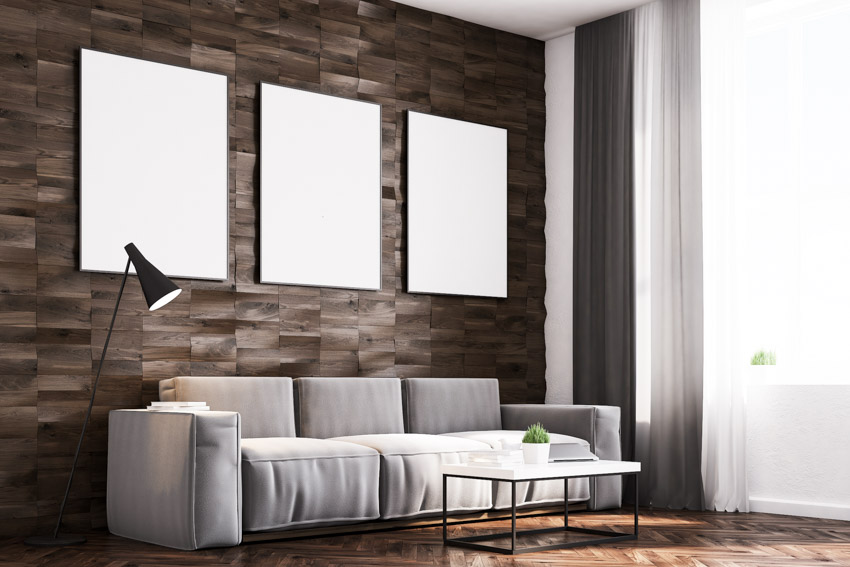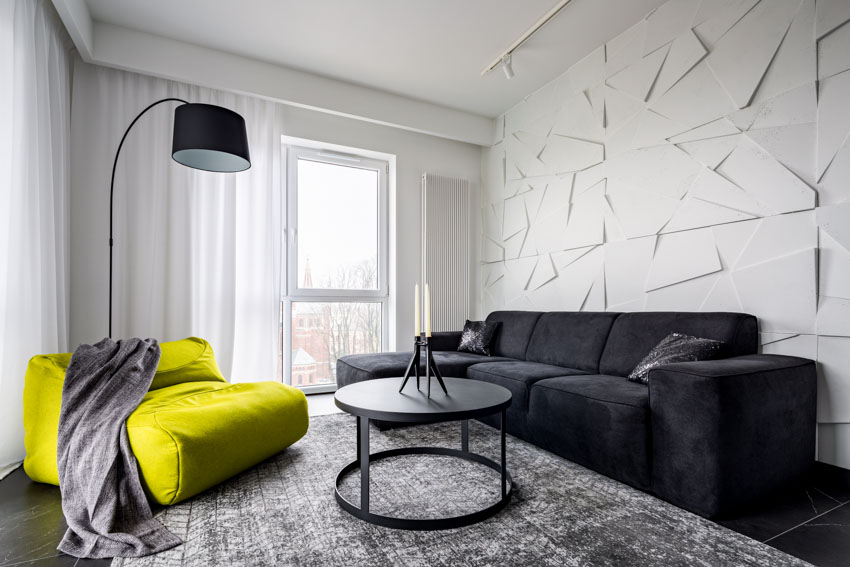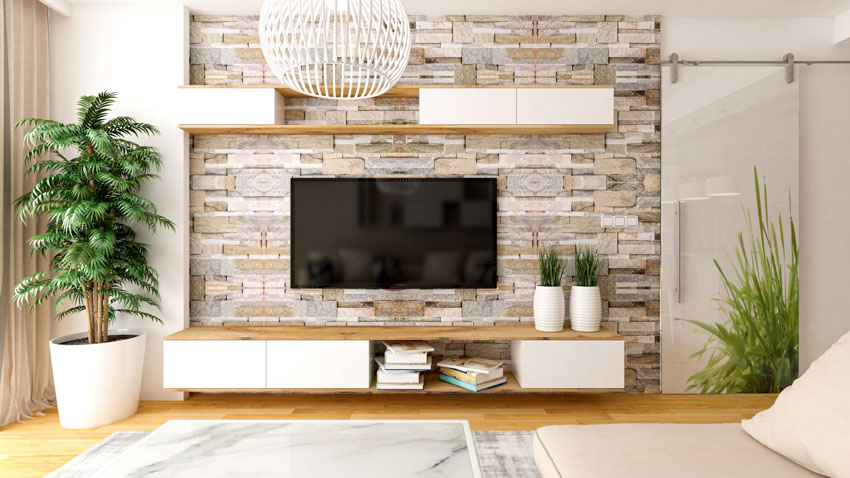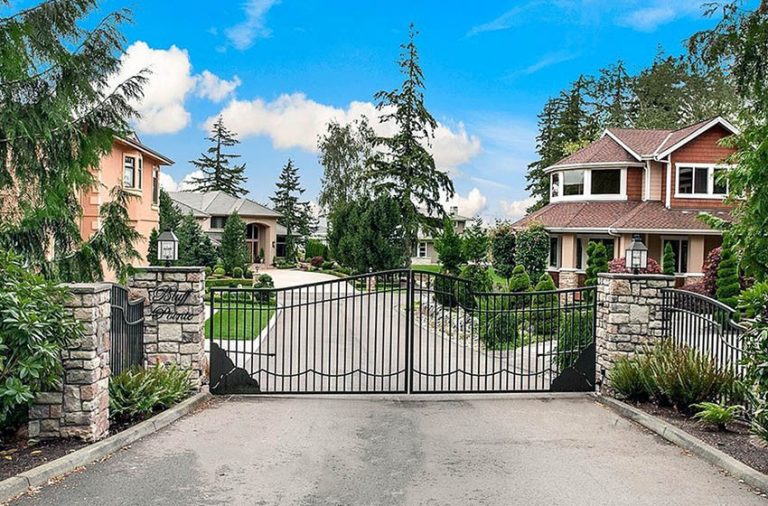Wall Cladding (Interior & Exterior Types)
Here we share our wall cladding guide including what it is, different types, options for exteriors & interiors, prices and best wall cladding designs to choose.
 The majority of homeowners simply paint their interior wall surfaces and cover their exteriors with conventional siding. However, savvy homeowners employ wall cladding to not only add distinctive character to their residence but also to protect it from harmful elements and moisture.
The majority of homeowners simply paint their interior wall surfaces and cover their exteriors with conventional siding. However, savvy homeowners employ wall cladding to not only add distinctive character to their residence but also to protect it from harmful elements and moisture.
Siding adheres straight to the outer wall or sheathing, whereas wall cladding does not. Alternatively, it is placed on top of furring strips that divide the sheathing from the materials.
With better ventilation and a water-resistant layer created by this area, the cladding materials’ lifespan and the structural stability of your house are both increased.
Suppose you are interested in incorporating this design feature in your house. In that case, you should be knowledgeable of the various types of interior and exterior wall cladding as well as their advantages.
In this article, we will discuss the wall facade choices to help select the right material for your home.
What Is Cladding?

There are numerous types and forms of cladding that come in a variety of materials, patterns, and sizes. A building’s interior and exterior can both utilize wall claddings.
In addition to serving an aesthetic purpose, they also serve to defend the underlying framework. Buildings’ aesthetics, weather resistance, and heat insulation can all be improved using wall overlay.
While these wall sheathing materials are frequently referred to as siding in North America, the term “cladding” is frequently adopted in Europe and Australia. It serves to protect the structure from the elements outdoors while enhancing the architectural design of the structure.
Architectural veneers can reduce sound transmission via walls while also boosting the insulation of a structure. There are many different types and styles that come in various materials, patterns, and textures.
Types of Cladding for Walls

The following discusses each type of wall cladding.
Stone

The cost of natural stone cladding typically varies by stone type. The necessary shape and size have a significant impact on the price. Stone strips with 2 to 15 rows can be used to create cladding.
However, as a result, more glue is needed to adhere to the greater elements there are in a single stone cladding. It can be put in place over a steel or concrete surface.
Wood

It can be used as an interior wall cladding, for fixture and furniture construction or as a floor finish. It has warmth and is full of imperfections, which can add character to a space. – Basics Interior Design 01: Retail Design, Lynne Mesher
Moreover, wood is a fantastic insulator and is among the weather-resistant types of house siding. It is strong and simple to set up. Unrivaled aesthetic value is one of the most amazing things provided by the natural appearance of wood. Boards made of wood can also be used as flooring and for decking.
The wooden overlay is available as a shingle, panel, siding, or board that is horizontal. The actual wood appearance of wall cladding on the houses is rustic, warm, and appealing, making it a favorite choice for so many homeowners. It is an eco-friendly sheathing material and a useful natural barrier.
Pac Clad Panels

There are no-clip or clip-fastened panels available for each profile to allow for expansion and contraction. To give a building’s façade more aesthetic impact, these cladding panels can be blended together. Both horizontal and vertical installations are possible for these panels.
For any industrial metal wall panel, commercial metal siding panel, or retailing applications, the PAC-CLAD range of composite metal wall panel systems offers unparalleled performance and breathtaking visual impacts.
Moreover, these wall cladding materials are thermo-bonded to a polyethylene or fire-retardant substrate. Using computer-controlled routing technology, a route and return method is used to create panels. This state-of-art fabrication assures dimensional accuracy and exact panel measurements.
Composite

Although composite slate or wood wall cladding is more affordable, it still achieves the same aesthetic result and may be simpler to maintain.
Brick

The majority of bricks used for cladding are produced using specialized, cutting-edge machinery created in-house. It offers cooling in the summer and energy-efficient heating in the winter.
To capture renewable energy sources, they work flawlessly with receptive building design. Building temperatures are kept in check and energy consumption is decreased thanks to the inherent density and heat insulation properties of brick cladding.
Metal

Durable, long-lasting, lightweight metal cladding systems are normally available as they are the most preferred qualities by homeowners. Let us talk about the two popular types of metal cladding:
Stainless Steel: The stainless steel wall cladding is exceptionally sturdy and impervious to environmental factors. The stainless steel has a significant amount of chromium, which when combined with oxygen forms a non-porous passive coating of chromium oxide that prevents continued corrosion.
Moreover, stainless steel cladding is rust-proof, making it a long-lasting metal wall overlay. It can also be applied to carbon steels as well as moderate alloy steels. It is highly resistant to the impacts of the environment. It is made with a minimum of 10 percent of chromium so that when subjected to oxygen in the environment, an oxide of chromium would be formed.
Aluminum: Aluminum cladding offers a lot more considerable benefits in comparison to other metals. Aluminum weighs in at around a third of the mass of steel.
This renders aluminum a fantastic building material because it has a long lifespan. It may be recycled without sacrificing any of its strength and overall quality.
Aside from that, aluminum is continuously released, using minimal energy in the operation. It can be easily shaped in many shapes, sizes, and finishes, rendering it a metal that may be utilized for multiple purposes. Read more about aluminum house siding here.
PVC (Polyvinyl Chloride)

PVC wall sheathing panels can even be attached with a supplementary insulating material that provides a temperature-controlling sheet over your home, making the space warmer in the wintertime and refreshing in the summertime.
PVC is far lighter than its competitors, allowing wall overlay panels to be entirely flexible when coating a structure. It is dent-resistant & flake-proof and thus does not necessitate repainting.
Limestone

As it generates a visual barrier in open areas, interior limestone wall overlay would be ideal as a highlight or major wall in certain types of room in a house, such as a restroom, bedroom, family room, or dining area.
Exterior limestone wall overlay also provides textures and layers that can add appeal to façades. Indeed, limestone cladding may provide significant attractiveness to outdoor kitchens, perimeter outside walls in landscapes, and surrounding swimming pools, just to mention a few.
Another similar option to limestone with many of the same characteristics is travertine. However, while travertine may be less expensive it is also more porous which can be a problem for interior wet areas like the bathroom or kitchen or for exterior applications.
Exterior Cladding Types

Moreover, exterior wall sheathing significantly affects how much upkeep the building will need as years go by. There are several options available now for exterior cladding that can offer both aesthetic and practical benefits. The various kinds of exterior cladding materials that are offered on the market are listed hereunder:
Stainless Steel Exterior Wall Cladding: Due to its exceptional resistance to damaging outside impacts, stainless steel exterior wall laminate is highly regarded.
This enables it to produce a layer of chromium oxide when exposed to atmospheric oxygen. This acts as an additional layer of protection against rust.
Brick Exterior Wall Cladding: Brick overlay lends that visually appealing, rustic appearance to the exterior of a structure.
Although they are more pricey to set up initially than many of the other wall overlay options, they can be less costly to maintain. They are also extremely durable, fire-resistant, and long-lasting. They can even last for a lifetime.
Wooden Exterior Wall Cladding: The architectural attractiveness of wooden overlay is well-known and highly regarded. It might not be as strong and long-lasting as some of the other sheathing materials.
Unfortunately, however, when making wooden sheathing units, redwood and cedar are the two most popular and most durable wood options. The installation, as well as the general upkeep, are thought to be rather pricey for this one. Read more about types of exterior wood siding here
Fiber Cement Exterior Wall Cladding: Fiber cement overlay acts as a stronger substitute for wood laminate or stucco, especially in wet locations. Fiber cement siding offers excellent strength together with the visual appeal of wood siding.
Additionally, they necessitate practically no maintenance and are less costly than their wooden equivalents.
Stone Exterior Wall Overlay: The distinctively natural and fresh appearance of exterior stone overlay is widely admired. It fits flawlessly over surfaces that are either made of metal or concrete. Stone exterior claddings are normally essentially lightweight knockoffs of stone commodities with an installation-helping base made of concrete.
Vinyl Exterior Wall Cladding: One more of the many overlay alternatives available is vinyl overlay. For decorative and weatherproofing reasons, it is primarily employed in compact construction developments like apartments.
It might not be as good-looking as hardwood and other overlay materials, but it costs a lot less and is regarded as a good return on investment. See popular vinyl siding sizes on this page.
Aluminum Exterior Wall Overlay: Compared to the vinyl overlay typically used in dwellings, aluminum overlay is often a more pricey option. The increased durability and longer lifespan of these exterior claddings may be guaranteed, though, by using aluminum.
This sort of exterior wall application is quite easy to maintain and is often utilized in cellars, including on the storage walls of a structure. Bigger projects including business buildings may use treated aluminum exterior wall claddings of greater quality.
Interior Cladding Types

Stone Interior Wall Overlay: The stone interior wall overlay is recognized as the most natural-looking and youthful-looking veneer among all interior overlay options. It can be put in place over a metallic or concrete surface. These are regarded as lightweight imitation stone materials that are installed easily thanks to a concrete-like base.
Moreover, stone overlay is mainly employed in the living rooms, interior gardens. It is also considered as an option for those in need of bathroom accent wall ideas. Although the overlay unit is quite robust, installation costs are rather costly.
Plastic (PVC) Interior Wall Overlay: Plastic (PVC) is one of the most commonly used over materials used for interior spaces since it is highly resilient and could maintain its original configuration for many generations.
Plastic wall sheathing is the ideal option if you regularly encounter bad weather because it can survive excessive heat, cold, and dampness. Some varieties can even withstand hurricane-force winds.
PVC overlay is fairly affordable when compared to other overlay materials like wood, stone, and brick. This kind of interior sheathing can readily maintain its appearance and shape over a lengthy amount of time, conserving your money on maintenance and replacement costs.
PVC panels are also fire resistant and can work well for kitchen walls behind the range or cooktop.
Metal Interior Wall Overlay: Probably among the most widely used and beneficial materials, steel or aluminum, are used to make the majority of metal interior overlay panels.
For interior structures with a higher danger of fire, like business kitchens, workshops, as well as warehouses, metal is a common choice.
Metal overlay is among the most aesthetically beautiful solutions, in addition to being practical and safe. Finding sheathing panels to match your interior design is simple because this sort of laminate is offered in a huge selection of styles and finishes, such as modern stainless steel and rustic metal.
Cladding Prices

Here are the approximate costs of different types of wall overlay per board and per square meter:
• Composite Wall Sheathing: $20 to $25 (per board)
• Fiber Cement Wall Overlay: $17 to $20 (per board)
• Wooden Wall Sheathing: $15 to $50 (per square meter; the cost depends on the quality and type of wood)
• Aluminum Wall Overlay: $10 to $24 (per square meter)
• Vinyl Wall Overlay: $15 to $20 (per square meter)
What Are the Types of Hygienic Cladding?

The purposes mentioned above are varied, but one benefit of veneer is that PVC can be produced in a wide range of shapes and colors to satisfy various aesthetic requirements.
These options allow hygienic sheathing to be modified for various uses, sizes, and types. The following are the two well-known manufacturers of PVC hygienic overlay:
AquaClad: Shower rooms, bathtub spaces, and other wet areas can all use AquaClad. Best employed in home settings, this hygienic overlay solution is non-porous and mold-free.
There is no need to sacrifice the design and color combination because AquaClad is available in 8 different finishes!
Plasiax: Plasiax cladding is superior to the competition when it pertains to PVC wall overlay that satisfies all the requirements. It is ideal for placement in hospitals, laboratories, health centers, prisons, hotels, and food preparation sectors.
This is because of its maximum-impact strength and immunity to chemicals, mold, mildew, and other bacteria kinds. The product’s various color finishes work well with its technical specifications.
What Is the Best Cladding for Interiors?

Almost any aesthetic can benefit greatly from natural stone interior wall overlay, which contrasts wonderfully with modern color palettes and blends in with the unpretentious simplicity of rustic themes.
What Is The Best Cladding for Exteriors?

Furthermore, bricks are fire-resistant, structurally robust, long-lasting, recyclable, weather-resistant, easy to maintain, and non-toxic, and they offer superb sound insulating properties.
Moreover, brickpanel overlay has additional design options thanks to the wide range of colors, forms, finishes, and textures available.
See more related content in our article about the different types of wood wall paneling on this page.






